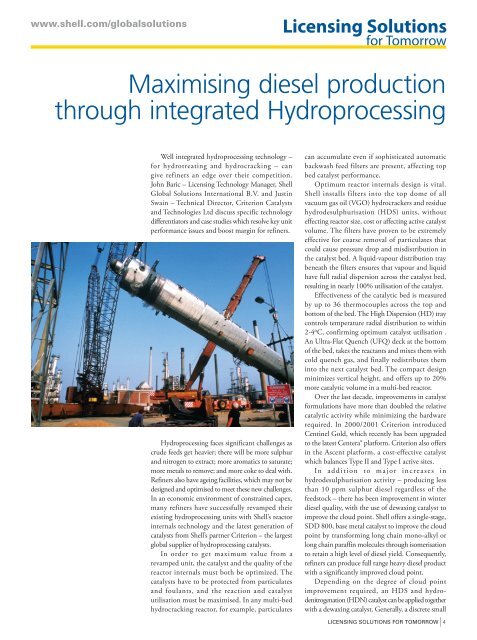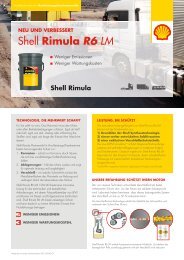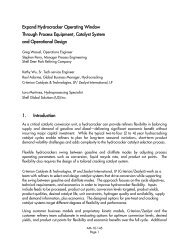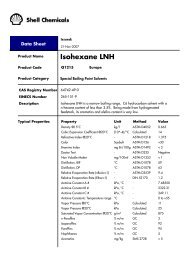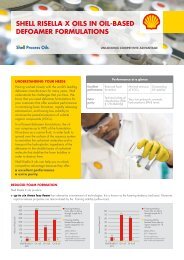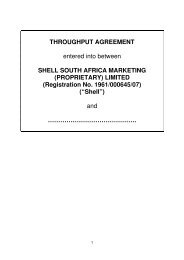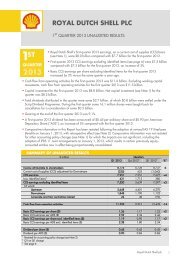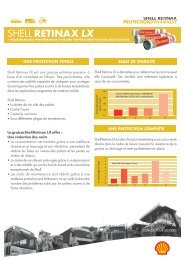Shell Global Solutions - Licensing Solutions for Tomorrow ...
Shell Global Solutions - Licensing Solutions for Tomorrow ...
Shell Global Solutions - Licensing Solutions for Tomorrow ...
Create successful ePaper yourself
Turn your PDF publications into a flip-book with our unique Google optimized e-Paper software.
www.shell.com/globalsolutions<br />
<strong>Licensing</strong> <strong>Solutions</strong><br />
<strong>for</strong> <strong>Tomorrow</strong><br />
Maximising diesel production<br />
through integrated Hydroprocessing<br />
Well integrated hydroprocessing technology –<br />
<strong>for</strong> hydrotreating and hydrocracking – can<br />
give refiners an edge over their competition.<br />
John Baric – <strong>Licensing</strong> Technology Manager, <strong>Shell</strong><br />
<strong>Global</strong> <strong>Solutions</strong> International B.V. and Justin<br />
Swain – Technical Director, Criterion Catalysts<br />
and Technologies Ltd discuss specific technology<br />
differentiators and case studies which resolve key unit<br />
per<strong>for</strong>mance issues and boost margin <strong>for</strong> refiners.<br />
Hydroprocessing faces significant challenges as<br />
crude feeds get heavier; there will be more sulphur<br />
and nitrogen to extract; more aromatics to saturate;<br />
more metals to remove; and more coke to deal with.<br />
Refiners also have ageing facilities, which may not be<br />
designed and optimised to meet these new challenges.<br />
In an economic environment of constrained capex,<br />
many refiners have successfully revamped their<br />
existing hydroprocessing units with <strong>Shell</strong>’s reactor<br />
internals technology and the latest generation of<br />
catalysts from <strong>Shell</strong>’s partner Criterion – the largest<br />
global supplier of hydroprocessing catalysts.<br />
In order to get maximum value from a<br />
revamped unit, the catalyst and the quality of the<br />
reactor internals must both be optimized. The<br />
catalysts have to be protected from particulates<br />
and foulants, and the reaction and catalyst<br />
utilisation must be maximised. In any multi-bed<br />
hydrocracking reactor, <strong>for</strong> example, particulates<br />
can accumulate even if sophisticated automatic<br />
backwash feed filters are present, affecting top<br />
bed catalyst per<strong>for</strong>mance.<br />
Optimum reactor internals design is vital.<br />
<strong>Shell</strong> installs filters into the top dome of all<br />
vacuum gas oil (VGO) hydrocrackers and residue<br />
hydrodesulphurisation (HDS) units, without<br />
effecting reactor size, cost or affecting active catalyst<br />
volume. The filters have proven to be extremely<br />
effective <strong>for</strong> coarse removal of particulates that<br />
could cause pressure drop and misdistribution in<br />
the catalyst bed. A liquid-vapour distribution tray<br />
beneath the filters ensures that vapour and liquid<br />
have full radial dispersion across the catalyst bed,<br />
resulting in nearly 100% utilisation of the catalyst.<br />
Effectiveness of the catalytic bed is measured<br />
by up to 36 thermocouples across the top and<br />
bottom of the bed. The High Dispersion (HD) tray<br />
controls temperature radial distribution to within<br />
2-4 o C, confirming optimum catalyst utilisation .<br />
An Ultra-Flat Quench (UFQ) deck at the bottom<br />
of the bed, takes the reactants and mixes them with<br />
cold quench gas, and finally redistributes them<br />
into the next catalyst bed. The compact design<br />
minimizes vertical height, and offers up to 20%<br />
more catalytic volume in a multi-bed reactor.<br />
Over the last decade, improvements in catalyst<br />
<strong>for</strong>mulations have more than doubled the relative<br />
catalytic activity while minimizing the hardware<br />
required. In 2000/2001 Criterion introduced<br />
Centinel Gold, which recently has been upgraded<br />
to the latest Centera® plat<strong>for</strong>m. Criterion also offers<br />
in the Ascent plat<strong>for</strong>m, a cost-effective catalyst<br />
which balances Type II and Type I active sites.<br />
In addition to major increases in<br />
hydrodesulphurisation activity – producing less<br />
than 10 ppm sulphur diesel regardless of the<br />
feedstock – there has been improvement in winter<br />
diesel quality, with the use of dewaxing catalyst to<br />
improve the cloud point. <strong>Shell</strong> offers a single-stage,<br />
SDD 800, base metal catalyst to improve the cloud<br />
point by trans<strong>for</strong>ming long chain mono-alkyl or<br />
long chain paraffin molecules through isomerisation<br />
to retain a high level of diesel yield. Consequently,<br />
refiners can produce full range heavy diesel product<br />
with a significantly improved cloud point.<br />
Depending on the degree of cloud point<br />
improvement required, an HDS and hydrodenitrogenation<br />
(HDN) catalyst can be applied together<br />
with a dewaxing catalyst. Generally, a discrete small<br />
<strong>Licensing</strong> <strong>Solutions</strong> <strong>for</strong> <strong>Tomorrow</strong> I 4
<strong>Licensing</strong> <strong>Solutions</strong><br />
<strong>for</strong> <strong>Tomorrow</strong><br />
www.shell.com/globalsolutions<br />
dewaxing bed is used where temperature, dewaxing<br />
and cold flow improvement can be controlled.<br />
Criterion produces a range of hydrocracking<br />
catalysts in partnership with Zeolyst International.<br />
Blends of zeolite differ according to the level of<br />
diesel selectivity required in different markets. The<br />
new 2000 series of zeolite catalysts offers refiners<br />
the flexibility to choose more diesel selectivity at<br />
the same operating temperature, or more activity<br />
<strong>for</strong> the same selectivity, achieving highest boost in<br />
diesel production within existing unit constraints.<br />
Catalyst shape is also an important per<strong>for</strong>mance<br />
variable. Criterion had replaced cylinders with<br />
trilobes to boost hydrocracking per<strong>for</strong>mance and<br />
increase diesel production. Over-cracking occurs<br />
if the reactants remain inside the catalyst too long,<br />
reducing diesel yield and creating more undesired<br />
product like naphtha and gas. Criterion’s new<br />
Advanced Trilobe Xtreme (ATX) shape has further<br />
increased diesel yield by 1.5%. A 50,000 bpd<br />
hydrocracker can produce 750 bpd more diesel<br />
product simply by changing catalyst shape.<br />
Let us examine two case studies: a dewaxing<br />
project where <strong>Shell</strong> was asked to improve the cloud<br />
point of winter diesel by 14 o C and a revamp of a<br />
30-year old hydrocracker with reliability issues.<br />
Many hydroprocessing assets worldwide are<br />
underper<strong>for</strong>ming. A successful revamp project is<br />
low capex with quick payback, ideally within the<br />
subsequent catalyst cycle of the hydroprocessing<br />
unit. Typically, the project is scoped <strong>for</strong> new reactor<br />
internals and a new catalyst package – and its far<br />
better to do them together than separately.<br />
For upgrading old, low-pressure HDS units,<br />
which do not have enough catalyst volume,adding<br />
a second reactor makes a significant improvement in<br />
per<strong>for</strong>mance. A review of the wash-water injection<br />
system is also important. Often feed rate and/or sour<br />
feed rate are increased triggering potential corrosion<br />
problems that can be avoided by additional/optimised<br />
wash water operation. At the back end, the refiner<br />
must ensure that separation, fractionation and workup<br />
sections can recover the additional diesel product.<br />
Depending on the scope, costs of a revamp<br />
hydroprocessing project range from $2-10 million –<br />
with a second reactor at the upper end. A revamp can<br />
typically be carried out in a scheduled turnaround.<br />
Typical payback is within the next cycle and allows<br />
the refiner to process far more difficult feedstocks<br />
and/or produce better quality product.<br />
Case Study 1: An ultra-low sulphur (ULSD)<br />
unit was converted to dewaxing mode, capable of<br />
reducing the diesel cloud point from -5 to -19 o C,<br />
using a high activity nickel-molybdenum catalyst<br />
with SDD 800 dewaxing catalyst and some posttreatment,<br />
implemented within an existing reactor.<br />
Dewaxing requires operating flexibility, as cloud<br />
point improvement is not necessary in the summer.<br />
5 I<br />
<strong>Licensing</strong> <strong>Solutions</strong> <strong>for</strong> <strong>Tomorrow</strong><br />
During the summer, dewaxing can be switched off<br />
by quenching, at a small yield penalty. Two-stage<br />
iso-dewaxing offers up to 35 o C cloud point<br />
improvement with minimal diesel yield loss.<br />
Case Study 2: A single-stage, 30-year old<br />
hydrocracker (with recycle) had become less reliable<br />
with age, mainly due to a high catalyst bed pressuredrop<br />
through deposition of solids, corrosion<br />
products upstream of the unit. A top bed skim was<br />
frequently required and the top bed catalyst was<br />
completely replaced during plant turnaround. <strong>Shell</strong><br />
implemented new reactor internals technology,<br />
“Over the last decade,<br />
improvements in<br />
catalyst <strong>for</strong>mulations<br />
have more than doubled<br />
the relative catalytic<br />
activity while minimizing<br />
the hardware required.”<br />
including; a filter deck, increasing the cycle length<br />
and eliminating the rapid pressure-drop build up,<br />
and integrated HD/UFQ decks, increasing catalyst<br />
utilisation <strong>for</strong> higher diesel yields. The total project cost<br />
was about $2 million <strong>for</strong> hardware, and outstanding<br />
reliability and yield improvement achieved.<br />
Maldistribution of catalyst is a common problem<br />
<strong>for</strong> reactors, creating local hotspots when liquids<br />
and vapors flow preferentially to one part of a bed,<br />
leaving other parts without proper flow. The resultant<br />
high temperatures and overcracking generates high<br />
gas and LPG yields, consuming hydrogen, at the<br />
expense of diesel product. Ultimately, the operation<br />
is constrained on cycle length, because the reactor<br />
mechanical temperature limit is reached much faster<br />
if radials are 50°C hotter in one part of the bed than<br />
another, so full cycle potential is never achieved.<br />
Installing HD tray and UFQ quench decks resulted<br />
in stable catalyst per<strong>for</strong>mance, both temperatures<br />
and yields, in the subsequent cycle.<br />
The reactor internals were complemented by<br />
tailoring a combination of high-activity catalysts with<br />
optimum selectivity resulting in increased conversion<br />
(by 2.5% on feed) and increased diesel yield (diesel<br />
yield actually increased by 10% weight on feed).<br />
Payback was less than a year, given increased<br />
unit per<strong>for</strong>mance worth $3.5 million annually. <br />
John Baric – <strong>Licensing</strong> Technology Manager,<br />
<strong>Shell</strong> <strong>Global</strong> <strong>Solutions</strong> International B.V.<br />
Justin Swain – Technical Director,<br />
Criterion Catalysts and Technologies Ltd


